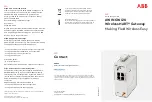
74
09 Software
Virtual COM Port Driver
To use the ARCP-890 or ARHP-890 through a USB connection, or to use other application software which control the
TS-890S through the RS-232C, a virtual COM port driver needs to be installed.
A virtual COM port driver is a free software application and can be downloaded free of charge from the KENWOOD
website.
For a connection through an RS-232C cable or through a LAN cable, a virtual COM port driver does not need to be
installed.
To use only the ARUA-10 with a USB cable connection, a virtual COM port driver does not need to be installed. To use
the USB sound function implemented in the TS-890S, TS-890S functions with the Windows sound driver.
The TS-890S virtual COM port has 2 types: the virtual COM (Standard) port and the virtual COM (Enhanced) port.
The COM port numbers of the virtual COM (Standard) port and virtual COM (Enhanced) port on a PC can be confirmed
in the following way:
• Start the Windows Device Manager.
• The following two COM ports appear in “Ports (COM & LPT)” of the Device Manager when the TS-890S is connected through
USB cable.
“Silicon Labs CP210x USB to UART Bridge (COM x)”
“Silicon Labs CP210x USB to UART Bridge (COM y)”
Numbers are entered in the x and y parts. Numbers vary depending on the environment of a PC used. The following
image shows an example where the virtual COM ports of the transceiver are assigned to COM3 and COM4.
• Double-click these in the Device Manager to display each property window.
• Select the “Details” tab and then select the “Location paths” in the pulldown menu of property.
• Move the mouse cursor to the top row in the “Value” area and confirm the number in the parenthesis which is the right-most
part of the text.
A row which displays (1) is the virtual COM (Standard) port of the transceiver.
A row which displays (2) is the virtual COM (Enhanced) port of the transceiver.
Note:
◆ To use the ARCP-890 or ARHP-890 through a USB connection, or to use other application software which control the
TS-890S through the RS-232C, use the virtual COM (Standard) port.















































